The Liquid Filled Capsule Market is estimated to be valued at USD 1639.3 million in 2025 and is projected to reach USD 2181.8 million by 2035, registering a compound annual growth rate (CAGR) of 2.9% over the forecast period.
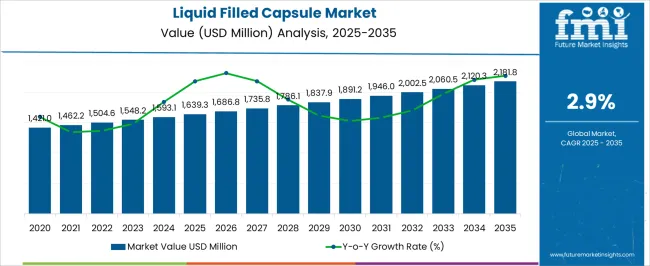
| Metric | Value |
|---|---|
| Liquid Filled Capsule Market Estimated Value in (2025 E) | USD 1639.3 million |
| Liquid Filled Capsule Market Forecast Value in (2035 F) | USD 2181.8 million |
| Forecast CAGR (2025 to 2035) | 2.9% |
The liquid filled capsule market is expanding at a significant pace, driven by rising consumer preference for easy-to-swallow, bioavailable dosage forms in pharmaceuticals and nutraceuticals. Growth is further supported by advancements in encapsulation technologies that enable improved stability of sensitive active ingredients and facilitate controlled release.
Increasing demand for dietary supplements, coupled with the rising prevalence of lifestyle-related disorders, has strengthened the market outlook. Manufacturers are focusing on gelatin and non-gelatin raw materials to address diverse dietary and cultural preferences, ensuring broader accessibility.
The current scenario highlights the segment’s adoption across functional foods, healthcare, and personal wellness industries. With ongoing innovation in capsule design and rising investments in contract manufacturing, the liquid filled capsule market is positioned for strong expansion across global healthcare and nutritional sectors.
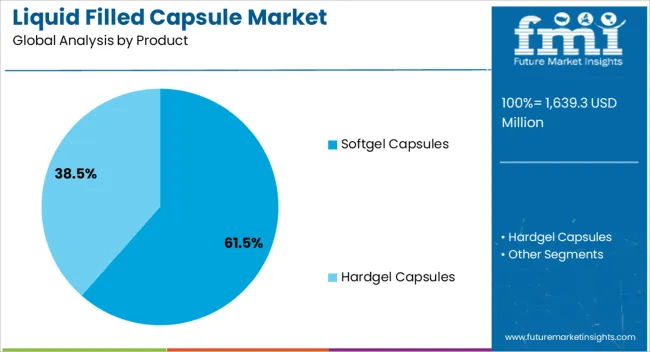
The softgel capsules segment leads the product category with approximately 61.50% share, reflecting its widespread acceptance in both nutraceutical and pharmaceutical applications. Its dominance is reinforced by consumer preference for easy-to-ingest forms with enhanced bioavailability of active ingredients.
The segment benefits from established manufacturing infrastructure, scalability, and compatibility with diverse oil-based formulations. Softgel capsules are also favored for masking unpleasant tastes and odors, thereby improving patient compliance.
Growth is driven by rising demand in vitamins, dietary supplements, and therapeutic drugs requiring lipid-soluble ingredient delivery. With ongoing innovation in plant-based alternatives and advancements in capsule filling technologies, the softgel capsules segment is expected to maintain its strong leadership position.
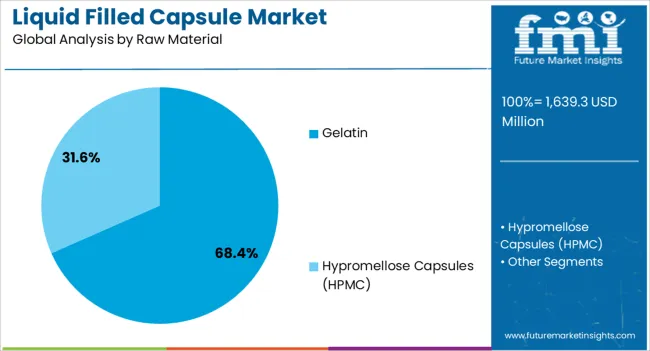
The gelatin segment dominates the raw material category, holding approximately 68.40% share of the liquid filled capsule market. Gelatin’s widespread adoption is attributed to its proven film-forming properties, stability, and cost-effectiveness in large-scale manufacturing.
The material’s versatility allows encapsulation of oils, suspensions, and semi-solids, reinforcing its continued preference across the industry. While regulatory and cultural considerations are fueling demand for non-gelatin alternatives, gelatin maintains its market leadership due to established supply chains and manufacturing expertise.
Continuous improvements in high-quality, pharmaceutical-grade gelatin have further supported its application. With sustained demand from dietary supplement and pharmaceutical sectors, the gelatin segment is expected to retain its dominant position in the near term.
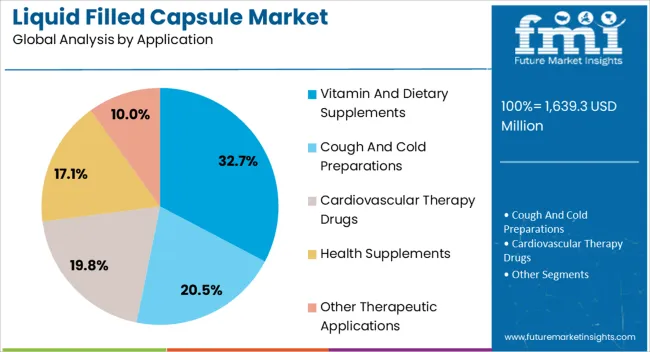
The vitamin and dietary supplements segment accounts for approximately 32.70% share of the application category in the liquid filled capsule market. Its growth is fueled by increasing consumer focus on preventive healthcare, nutritional supplementation, and wellness.
Capsules are widely utilized for delivering fat-soluble vitamins, herbal extracts, and dietary oils, aligning with lifestyle-driven health trends. Rising disposable incomes, expanding distribution networks, and growing e-commerce penetration have further supported market growth.
The segment’s adoption is reinforced by product innovation in functional supplements targeting immunity, energy, and cognitive support. With consumer awareness of preventive nutrition expected to rise, the vitamin and dietary supplements segment is likely to sustain robust growth and remain a key driver of market expansion.
The global liquid-filled capsule market recorded a historical CAGR of 2.5% from 2020 to 2025. In 2025, the market attained a valuation of USD 1,548.2 million.
The market for liquid-filled capsules has grown as a result of the expansion of the nutraceutical industry. Vitamins, minerals, and other nutritional supplements are frequently delivered in liquid-filled capsule form, which is in line with the rising consumer interest in health & wellness.
Improvements in encapsulation techniques and quality control procedures, among other advancements in capsule manufacturing technology, have increased the productivity and dependability of creating liquid-filled capsules. By achieving quality requirements and enhancing production capacities, this has helped the market to flourish.
Liquid-filled capsules have become widely used due to the requirement for specific drug delivery methods and the movement toward personalized medicine. These capsules provide customization in terms of dosages, combinations, and release profiles to cater to the specific needs of each patient.
Higher-quality liquid-filled capsules have resulted from improvements in the accuracy and efficiency of the encapsulation process brought about by advancements in capsule manufacturing technologies. The use of substitute materials for capsule shells has increased, particularly to satisfy the needs of vegetarian and vegan customers. Alternatives to conventional gelatin, such as plant-based gelatin, are gaining traction in the market.
The table below shows the estimated growth rates of the top five countries. Japan, China, and India are set to record high CAGRs of 7.4%, 7.0%, and 5.7%, respectively, through 2035.
| Countries | Value CAGR |
|---|---|
| United States | 3.7% |
| China | 7.0% |
| India | 5.7% |
| Japan | 7.4% |
| Germany | 4.8% |
The United States dominated the global market with a 33.3% share in 2025. The regulatory environment in the United States significantly impacts the liquid-filled capsule market.
The Food and Drug Administration (FDA) of the United States established stringent regulatory standards for pharmaceuticals and healthcare products. The regulatory framework ensures that drugs and dosage forms, including liquid-filled capsules, are safe, effective, and high quality.
Consumers and healthcare professionals have confidence in the safety and quality of pharmaceutical products because of the FDA's rigorous approval process and adherence to Good Manufacturing Practices (GMP). The United States' reputation for manufacturing high-quality pharmaceuticals is attributed to its strong regulatory framework, which draws domestic and foreign pharmaceutical companies to invest in and support the market.
Rising demand has been witnessed in the United States nutraceutical market, driven by product innovation and less stringent regulatory hurdles than those mandated for the pharmaceutical industry in other Western economies. Hence, the growing demand in the nutraceutical space is expected to drive the market for liquid filled capsules in the forecast period.
China has implemented extensive healthcare reforms to increase the quality of medical care, easy access to healthcare services, and foster innovation in the pharmaceutical industry. The demand for pharmaceutical products, particularly innovative drug delivery systems like liquid-filled capsules, is rising.
It is due to the expansion of healthcare coverage and focus on preventative care. Pharmaceutical firms in China are launching novel dosage forms to address the changing demands of the populace regarding healthcare.
In India, the cost-effectiveness of manufacturing pharmaceutical products, including liquid-filled capsules, is a key factor influencing the market. India is renowned for its ability to produce innovative capsule delivery systems and generic medications at a low cost of production.
The cost benefits in the market result from cheaper labor, accessible raw materials, and effective production methods. India-based pharmaceutical companies are making significant research and development investments to expand their product lines and provide cutting-edge dosage forms, such as liquid-filled capsules, at competitive pricing.
Japan’s pharmaceutical industry increasingly uses cutting-edge drug delivery techniques to improve patient compliance and medication efficacy. For certain formulations, liquid-filled capsules are estimated to be the better option.
Pharmaceutical regulations in Japan are quite stringent. Companies involved in the liquid-filled capsule business must abide by these rules.
Consumers typically prioritize safe and high-quality products in Japan. To achieve consumer expectations, manufacturers in the liquid-filled capsule market must guarantee product quality, stability, and adherence to safety regulations.
Germany’s liquid filled capsule market is positively influenced by cutting-edge technologies in capsule manufacturing. Manufacturers are enhancing encapsulation procedures and quality control techniques to guarantee product quality and consistency of their product in the market.
Sustainability of the environment is a key priority among companies in Germany. Companies in the liquid-filled capsule market are directing toward eco-friendly packaging solutions and materials to comply with the nation's environmental objectives.
The below section shows the softgel capsule segment dominating by product type. It is expected to surge at a CAGR of 2.7% by 2035. Based on raw material, the gelatin segment is anticipated to hold the dominant share through 2025. It is projected to rise at a CAGR of 2.6% through 2035.
| Segment | Value CAGR |
|---|---|
| Gelatin (Raw Material) | 2.6% |
| Pharmaceutical Companies (End-user) | 2.1% |
| Vitamin and Dietary Supplements (Application) | 2.1% |
| Softgel Capsules (Products) | 2.7% |
Softgel capsules dominated the global market with a 67.6% market share in 2025. Softgel capsules provide improved bioavailability, ease of swallowing, and compatibility with several formulations. Consumers favor softgel capsules due to their smooth texture and perceived effectiveness, which makes them a popular option for pharmaceutical, nutraceutical, and cosmetic products.
Softgel capsules also offer efficient packaging that shields the contents from outside influences like moisture and light. This enhances the encapsulated product's stability and shelf life. Consumers are expected to find softgel capsules simpler to swallow than tablets or hard capsules, which is anticipated to drive softgel capsule sales.
Gelatin dominated the global market with a 73.4% market share in 2025. The segment is projected to continue experiencing high growth throughout the forecast period.
The key ingredient used in producing liquid filled capsules is gelatin made from animal collagen. Gelatin contributes to the liquid-filled capsules' stability and longer shelf life by acting as an efficient barrier to shield the encapsulated substance from external influences.
With the rise of vegan trend, consumers are looking for vegan alternatives to liquid filled capsules made from gelatin. Manufacturers are adopting alternatives such as hydroxypropyl methylcellulose (HPMC) to accommodate consumers' dietary requirements.
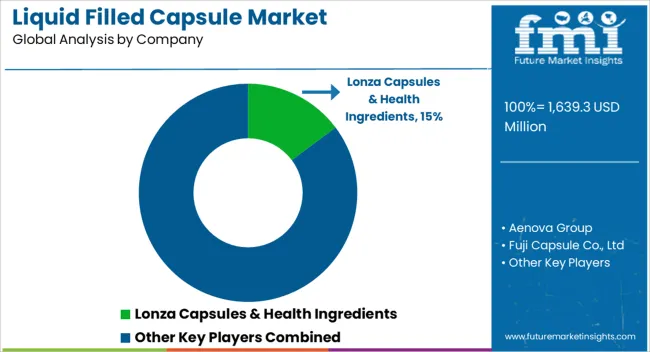
The market for liquid filled capsules is quite fragmented with several leading competitors. Key players are directed toward growth strategies such as partnerships, collaborations, product launches, acquisitions, and mergers to satisfy customer demand and grow their clientele.
For instance,
| Attribute | Details |
|---|---|
| Estimated Value (2025) | USD 1639.3 million |
| Projected Value (2035) | USD 2181.8 million |
| Anticipated Growth Rate (2025 to 2035) | 2.9% |
| Forecast Period | 2025 to 2035 |
| Historical Data Available for | 2020 to 2025 |
| Market Analysis | USD million for Value |
| Key Regions Covered | North America; Latin America; South Asia and Pacific; East Asia; Western Europe; Eastern Europe; Middle East and Africa |
| Key Countries Covered | United States, Canada, Mexico, Brazil, Chile, China, Japan, South Korea, India, Association of Southeast Asian Nations, Australia and New Zealand, Germany, Italy, France, United Kingdom, Spain, BENELUX, Nordic Countries, Russia, Hungary, Poland, Saudi Arabia, Türkiye, South Africa, Other African Union. |
| Key Market Segments Covered | Product, Raw Material, Application, End-user, and Region |
| Key Companies Profiled | Lonza Capsules & Health Ingredients; Aenova Group; Fuji Capsule Co., Ltd; Catalent, Inc.; EuroCaps Ltd; Guangdong Yichao Biotechnology Co., Ltd.; Captek Softgel International Inc.; Soft Gel Technologies Inc.; Thermo Fisher Scientific Inc. (Patheon); Delpharm Evreux; Curtis Health Caps; CapsCanada; Altasciences; Fermentis Life Sciences; ACG; Sunil Healthcare Limited; Ascendia Pharmaceuticals; LIQUIDCAPSULE MANUFACTURING LLC; SMPNutra.com |
| Report Coverage | Market Forecast, Competition Intelligence, Drivers, Restraints, Opportunities, Trends Analysis, Market Dynamics and Challenges, Strategic Growth Initiatives |
The global liquid filled capsule market is estimated to be valued at USD 1,639.3 million in 2025.
The market size for the liquid filled capsule market is projected to reach USD 2,181.8 million by 2035.
The liquid filled capsule market is expected to grow at a 2.9% CAGR between 2025 and 2035.
The key product types in liquid filled capsule market are softgel capsules and hardgel capsules.
In terms of raw material, gelatin segment to command 68.4% share in the liquid filled capsule market in 2025.






Full Research Suite comprises of:
Market outlook & trends analysis
Interviews & case studies
Strategic recommendations
Vendor profiles & capabilities analysis
5-year forecasts
8 regions and 60+ country-level data splits
Market segment data splits
12 months of continuous data updates
DELIVERED AS:
PDF EXCEL ONLINE
Liquid Filtration Market Size and Share Forecast Outlook 2025 to 2035
Liquid Packaging Board Market Size and Share Forecast Outlook 2025 to 2035
Liquid Density Meters Market Size and Share Forecast Outlook 2025 to 2035
Liquid Cold Plates Market Size and Share Forecast Outlook 2025 to 2035
Liquid Crystal Polymers Market Size and Share Forecast Outlook 2025 to 2035
Liquid Embolic Agent Market Size and Share Forecast Outlook 2025 to 2035
Liquid Hydrogen Market Size and Share Forecast Outlook 2025 to 2035
Liquid Cooled Home Standby Gensets Market Size and Share Forecast Outlook 2025 to 2035
Liquid Nitrogen Purge Systems Market Size and Share Forecast Outlook 2025 to 2035
Liquid Chromatography Systems Market Size and Share Forecast Outlook 2025 to 2035
Liquid Armor Materials Market Size and Share Forecast Outlook 2025 to 2035
Liquid Synthetic Rubber Market Size and Share Forecast Outlook 2025 to 2035
Liquid Crystal Polymer (LCP) Market Size and Share Forecast Outlook 2025 to 2035
Liquid Smoke Market Analysis - Size, Share, and Forecast Outlook 2025 to 2035
Liquid-Tight Flexible Non-Metallic Conduit Market Size and Share Forecast Outlook 2025 to 2035
Liquid Hand Soap Market Size and Share Forecast Outlook 2025 to 2035
Liquid Packaging Market Size and Share Forecast Outlook 2025 to 2035
Liquid-Tight Flexible Metal Conduit Market Size and Share Forecast Outlook 2025 to 2035
Liquid Breakfast Products Market Size and Share Forecast Outlook 2025 to 2035
Liquid Pouch Packing Machine Market Size and Share Forecast Outlook 2025 to 2035

Thank you!
You will receive an email from our Business Development Manager. Please be sure to check your SPAM/JUNK folder too.
Chat With
MaRIA